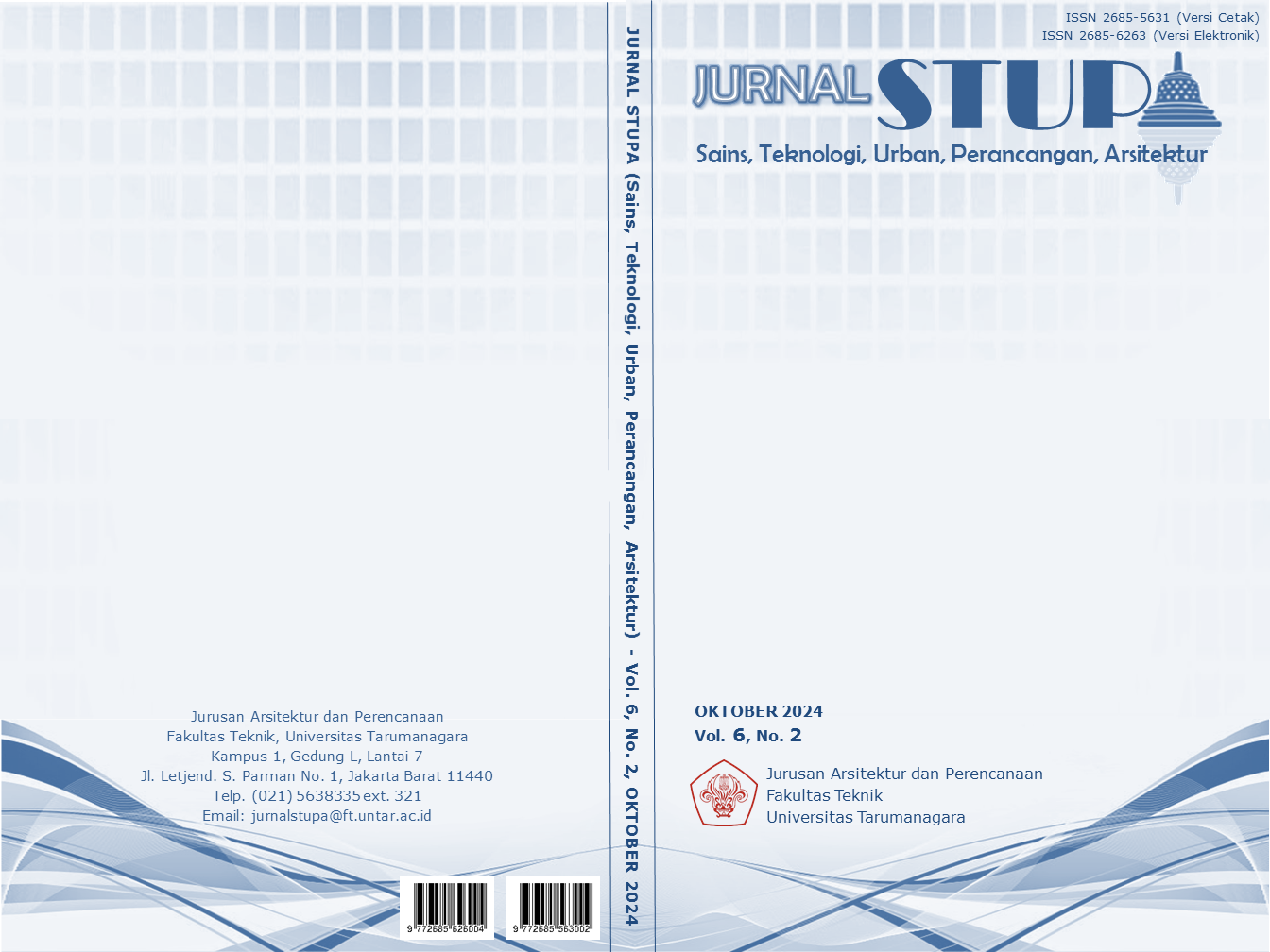REVITALISASI KAWASAN HARMONI: PENANGANAN SUDUT SIMPANG HARMONI DENGAN KARAKTER HIJAU
Main Article Content
Abstract
Harmoni junction reached its heyday in the 19th century marked by the emergence of the Societeit de Harmonie building and followed by the construction of hotels in the vicinity. However, the Harmoni intersection has experienced degradation of the area's vitality due to changes and developments. The Harmoni area in recent years has only become a transit point for Transjakarta users and is not as busy as it was during its heyday. Currently, Harmoni Intersection is undergoing development in terms of transportation with the construction of the Harmoni MRT station and the renovation of the Harmoni Transjakarta Central Shelter. In line with the development carried out by the government in terms of public transportation, it is necessary to develop functions and activities that can revive the Harmony Area. The method used is a qualitative and comparative method by examining the history of the development of the Harmony Area until it reached its heyday and the turning point of the reason for degradation to date. To obtain a proposal for a suitable function for the Harmony Area by handling the abandoned corner of the Harmoni Intersection of the former Hotel Des Galeries. The concept of a breathing place as a new landscape for the city of Jakarta can be a solution to revitalize the Harmony Intersection in the middle of the increasingly crowded city of Jakarta. In addition, the concept of a breathing place is harmonized with the idea of green architecture in helping to deal with pollution in Jakarta. Meanwhile, the addition of main entertainment functions such as aviaries as exhibitions, exhibitions about the history of Harmony Intersection and city parks, as well as main functions according to the needs of public transportation users such as working areas and coffee shops.
Keywords: Breathing Place; District Degradation; Green Architecture; Harmoni District; Revitalization
Abstrak
Simpang Harmoni mencapai masa kejayaannya pada abad 19 ditandai dengan munculnya bangunan Societeit de Harmonie dan diikuti dengan pembangunan hotel-hotel di sekitarnya. Namun, simpang Harmoni mengalami degradasi kevitalan kawasan akibat perubahan dan perkembangan zaman. Kawasan Harmoni beberapa tahun terakhir hanya menjadi tempat transit bagi pengguna Transjakarta dan tidak ramai aktivitas seperti saat masa kejayaannya. Saat ini, Simpang Harmoni sedang mengalami pengembangan dalam sisi transportasi dengan adanya pembangunan stasiun MRT Harmoni dan Renovasi Halte Sentral Transjakarta Harmoni. Selaras dengan pengembangan yang dilakukan pemerintah dari sisi transportasi publik, perlu dilakukan pengembangan fungsi dan aktivitas yang dapat menghidupkan Kawasan Harmoni kembali. Metode yang digunakan yaitu metode kualitatif dan komparatif dengan mengkaji sejarah dari perkembangan Kawasan Harmoni hingga mencapai masa kejayaannya dan titik balik alasan terjadi degradasi hingga saat ini. Untuk memperoleh usulan fungsi yang cocok bagi Kawasan Harmoni dengan penanganan Sudut Simpang Harmoni bekas Hotel Des Galeries yang terbengkalai. Konsep breathing place sebagai lanskap baru bagi Kota Jakarta, dapat menjadi solusi untuk memvitalkan kembali Simpang Harmoni di tengah Kota Jakarta yang semakin padat. Selain itu, konsep breathing place diselaraskan dengan konsep arsitektur hijau dalam membantu penanganan polusi di Jakarta. Sementara itu, dilakukan juga penambahan fungsi utama hiburan seperti aviari sebagai pameran, pameran tentang histori Simpang Harmoni dan taman kota, serta fungsi utama sesuai kebutuhan pengguna transportasi publik seperti working area dan coffee shop.
Article Details

This work is licensed under a Creative Commons Attribution-NonCommercial-ShareAlike 4.0 International License.
This work is licensed under a Jurnal Sains, Teknologi, Urban, Perancangan, Arsitektur/ STUPA Creative Commons Attribution-NonCommercial-ShareAlike 4.0 International LicenseReferences
Artyas, Y., & Warto. (2019). Societeit De Harmonie: European Elite Entertainment Center In The 19th Century In Batavia. Paramita: Historical Studies Journal, 130-138.
Danisworo, M. (2002). Revitalisasi Kawasan Kota: Sebuah Catatan dalam Pengembangan dan Pemanfaatan Kawasan Kota. Yogyakarta: Urdi Vol.13.
Heidegger, M. (1971). Building Dwelling Thinking. New York: Harper & Row.
Lynch, K. (1960). The Image of The City. Cambridge: MIT Press.
Marihandono, M. I. (2005). Sentralisme Kekuasaan Pemerintahan Herman Willem Daendels di Jawa 1808-1811: Penerapan Instruksi Napoleon Bonaparte. History Study Program, Postgraduate Program, Faculty of Cultural Sciences, Indonesia University, 43.
Milone, P. D. (1966). Queen City of The East: The Metamophosis of a Colonial Captiol. Michigan: University of Michigan.
Pallasma, J. (2005). The Eyes of The Skin. New York: John Wiley & Sons.
Rahardjo, A. (2023). Jakarta Marketbeat Reports. Jakarta: Cushman & Wakefield.
Relph, E. (1976). Place and Placelessness. London: Pion Limited.
Selviany, D. (2022, November 8). Sejarah Jakarta: Harmoni Dulu Tempat Cari Jodoh Kini Jadi Pusat Transit Bus Transjakarta. Retrieved from Wartakotalive.com: https://wartakota.tribunnews.com/2022/11/08/sejarah-jakarta-harmoni-dulu-tempat-cari-jodoh-kini-jadi-pusat-transit-bus-transjakarta#:~:text=Kawasan%20Harmoni%20terletak%20persis%20di,dari%20tempat%20transit%20Bus%20Transjakarta.
Shabab, A. (2009). Batavia Kota Banjir. Jakarta: Penerbit Republika.
Societat Harmonie Te Weltevreden Batavia 1905-1925. Inventaris Arsip Algemene Secretarie Serie Grote Bundel Ter Zijde Gelegde Agenda 1891-1942 jilid 1. Nomor Inventaris K81a, Nomor Arsip 7791. (n.d.). Jakarta: Arsip Negara Republik Indonesia.
Sutar, A. S., & Yogapriya, G. (2022). Green Architecture: A Notion of Sustainability. The Technoarete Transactions on Renewable Energy, Green Energy and Sustainability, 23-28.
Tuan, Y. F. (1977). Space and Place. Minneapolis: Minnesota Press.
Yusuf, M. (2017). Metode Penelitian: Kuantitatif, Kualitatif & Penelitian Gabungan. Jakarta: Kencana (Prenadamedia Group).
Zaenuddin HM. (2012). 212 Asal Usul Djakarta Tempo Doeloe. Jakarta: Ufuk Press.
Zuziak, Z. (1993). Managing Historic Cities. Cracow: International Cultural Centre.



